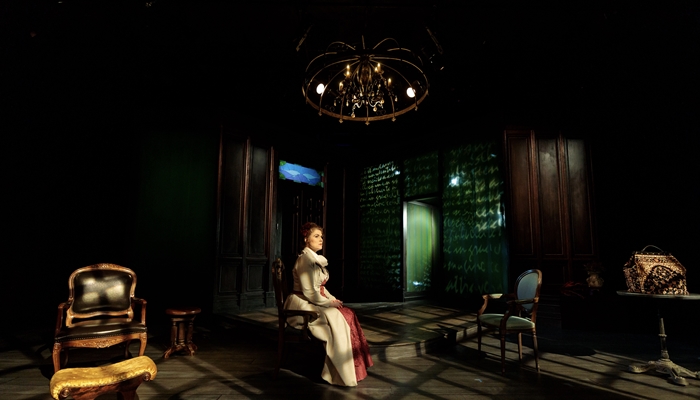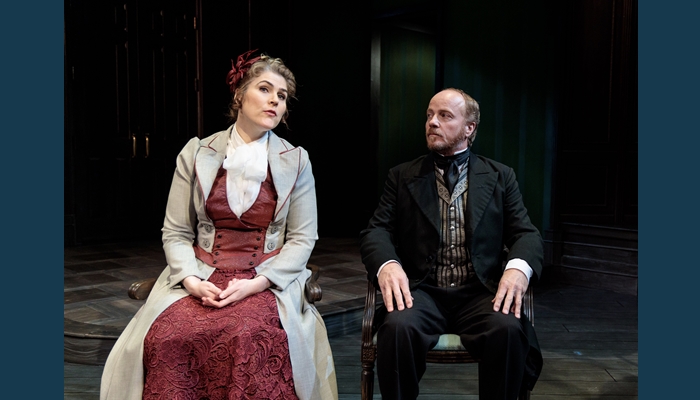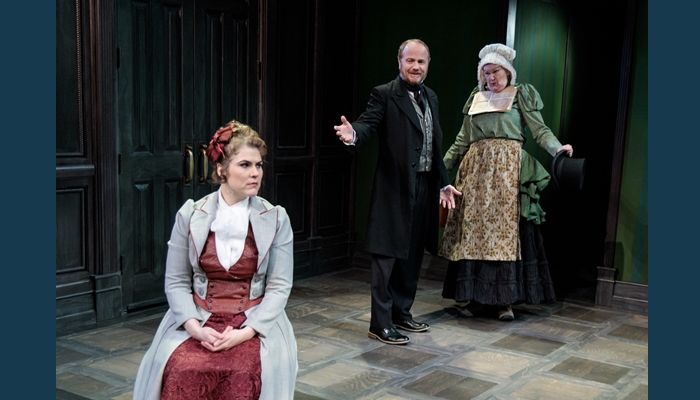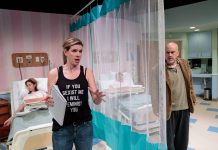
SALT LAKE CITY, Utah, Feb. 12, 2020 (Gephardt Daily) — OK, now because I know you’re curious, let’s get this out the way right off the top. No, you don’t really have to have seen or read “A Doll’s House” to enjoy “A Doll’s House, Part 2,” at Salt Lake Acting Company.
I personally have seen a reading of Henrik Ibsen’s classic 1879 play, but it was a while ago, so this time, I’m going to be honest with you, I read the Wikipedia page for the first play, and it served me just fine. But hey, if you’re going to see the sequel on a Valentine’s date, read the original, your sweetheart will be SO impressed.
What you really need to know going into the production was that at the end of the first “A Doll’s House,” Nora Helmer leaves her husband and children in what George Bernard Shaw called the “door slam heard ’round the world.” The closing of that door also symbolically marked the beginning of the feminist movement.
At the beginning of “A Doll’s House, Part 2,” by Lucas Hnath, a Utah premiere, there’s a knock on that same door 15 years later.
Nora’s back. But why? And where has she been? This clever sequel was nominated for eight Tony Awards and is the most produced play across the country this season, according to a list compiled annually by American Theater magazine.
The play, being produced in SLAC’s Upstairs Theatre through March 8, explores the aftermath of Nora’s choice, and how it has impacted both she and her family.
The play unfolds in a rather straightforward way. All taking place in the front room of the Helmer house, Nora first encounters her housekeeper, Anne Marie, then her husband Torvald, then, perhaps the hardest encounter of all, her daughter Emmy.
But she’s not back because she wants to return home; rather, Nora has become a successful feminist novelist, writing under a pseudonym. The reason for her return is to finalize a divorce from Torvald; she needs him to sign the legal papers. As she tells first Ann Marie, then the others, it undermines her credibility as a novelist who opposes marriage as an institution to still be married.
Stacey Jenson, making her SLAC debut as Nora Helmer, is masterful. It’s not an easy role; Nora has chunky swaths of dialogue that can at times border on the didactic. The way that Jenson plays her, though, is that Nora feels a desperate need (even for it’s for her own gain) to unpack her reasons for leaving and her reasons for coming back. Jenson portrays Nora as desperately, passionately standing on her soapbox like the Statue of Liberty, almost like she’s not able to step off for fear of revealing any shred of doubt about her decision. This motivates her sporadic loquaciousness and makes it mostly captivating.
Paul Mulder, as Torvald, also has a tough role; Nora tells Torvald at one point that he seems to observe himself feeling emotions rather than actually feeling them. That’s not an easy task for an actor, yet Mulder is curiously captivating. He plays Torvald as indeed seeming to watch himself with interest in this new, emotionally demanding situation, like it’s a lab experiment. It’s almost as if the character can’t quite catch up to the reality of Nora coming back; he seems clinical, detached, gently baffled rather than angry. But like in Jenson’s performance, there’s an undertone; this time of panic; he can’t let himself feel, otherwise he might fall apart.
Annette Wright as Anne Marie is the complete opposite: emotions and profanities flow forth from her in such a direct way that it’s comical; deliberately so. It’s as if everything that’s in her head needs to come out immediately; the character doesn’t have a filter. Wright is a gifted comic actress and her performance lends a needed lightness to the proceedings.
Rachael Merlot, who is also making her SLAC debut with this production, plays Emmy, who is almost the complete opposite of her mother in her conventional frame of mind. “I think it’s good to be stuck in a marriage,” she tells Nora. Merlot plays Emmy as vastly different from her mother in views, but oddly similar to her in personality; she’s strong, stoic, immovable about her beliefs.
The production values are sumptuous; scenic designer Erik Reichert has given us a jewel-toned front room that is handsome but barren, without the feminine touch. The back wall includes projections of writing, with the names of the characters projected when their scenes arrive. La Beene designed the costumes; Nora’s in particular is opulent, as if she’s trying to communicate that she’s flourishing financially. She wears dove gray and scarlet, including a velvet coat with puff sleeves that she sheds partway through, with a matching headpiece. Her costume too, is slightly masculine, which is entirely appropriate. The other characters’ ensembles are designed in watercolor colors as though they’ve just emerged from a Vermeer painting.
The lighting design too, by Matt Taylor, incorporates that feel of a painting, particularly when the door opens and closes.
The only difficulty I had with both the script and the direction is that the four characters are sometimes like talking heads, immovably stuck in their own worlds with their own beliefs. They talk; they listen less. They’re sometimes like four chess pieces that do not engage in a game. Nancy Borgenicht’s direction only highlights this; she loves to block her characters facing out so they can be seen clearly by the audience. This is valid in that we don’t miss much, but I would have liked to have seen a few more moments where the characters face each other straight on. Because of the style of direction, those moments would have even more impact.
The dialogue seems to indicate that it is the shock of Nora’s return that makes the characters so immobile in their beliefs. If they’ve felt them for the past 15 years since she left, I suppose it’s unrealistic that when she comes home their minds are immediately changed by what she says, or her mind is changed by them. So maybe this change happens after she leaves for the second time. Thus, the proverbial and literal door may open again for “A Doll’s House, Part 3.”
“A Doll’s House, Part 2,” runs through March 8, at 7:30 p.m. Wednesday through Saturday, and Sunday at 1 p.m. and 6 p.m. Tickets are $15 to $44, available by phone at 801-363-7522, or online here. SLAC is at 168 W. 500 North, Salt Lake City.












